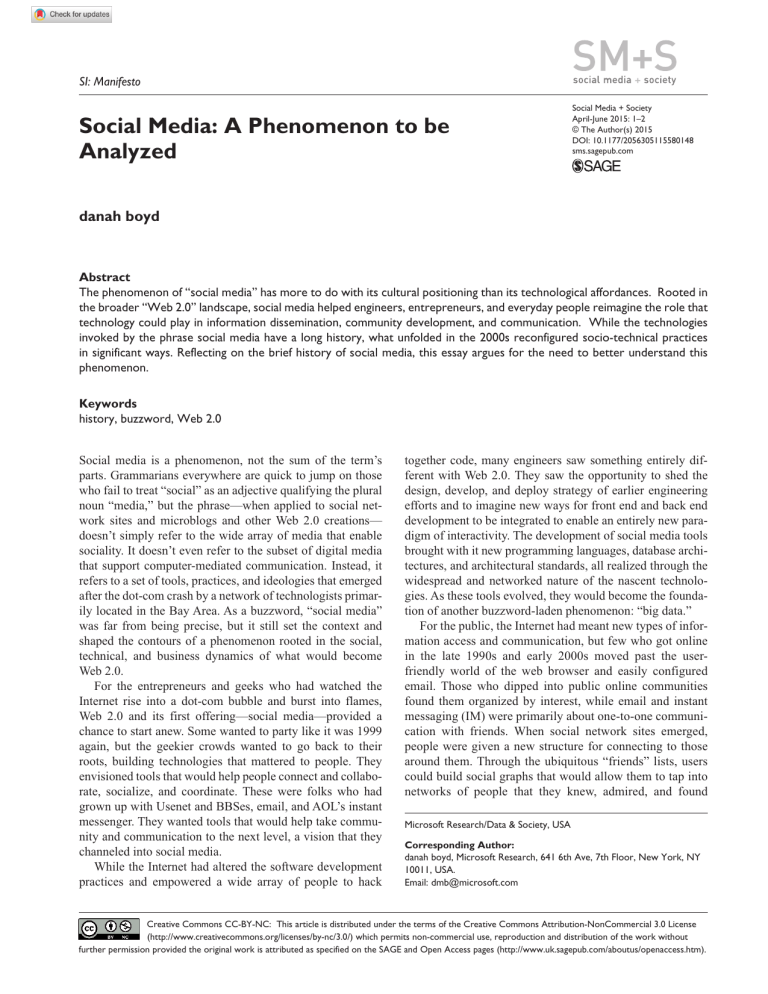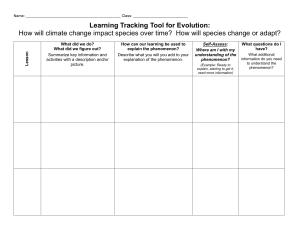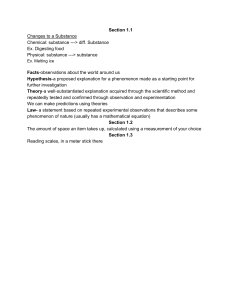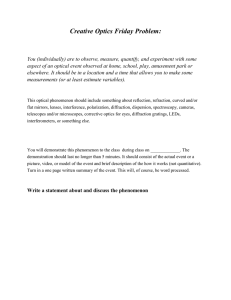
580148 research-article2015 SMSXXX10.1177/2056305115580148Social Media + Societyboyd SI: Manifesto Social Media: A Phenomenon to be Analyzed Social Media + Society April-June 2015: 1­–2 © The Author(s) 2015 DOI: 10.1177/2056305115580148 sms.sagepub.com danah boyd Abstract The phenomenon of “social media” has more to do with its cultural positioning than its technological affordances. Rooted in the broader “Web 2.0” landscape, social media helped engineers, entrepreneurs, and everyday people reimagine the role that technology could play in information dissemination, community development, and communication. While the technologies invoked by the phrase social media have a long history, what unfolded in the 2000s reconfigured socio-technical practices in significant ways. Reflecting on the brief history of social media, this essay argues for the need to better understand this phenomenon. Keywords history, buzzword, Web 2.0 Social media is a phenomenon, not the sum of the term’s parts. Grammarians everywhere are quick to jump on those who fail to treat “social” as an adjective qualifying the plural noun “media,” but the phrase—when applied to social network sites and microblogs and other Web 2.0 creations— doesn’t simply refer to the wide array of media that enable sociality. It doesn’t even refer to the subset of digital media that support computer-mediated communication. Instead, it refers to a set of tools, practices, and ideologies that emerged after the dot-com crash by a network of technologists primarily located in the Bay Area. As a buzzword, “social media” was far from being precise, but it still set the context and shaped the contours of a phenomenon rooted in the social, technical, and business dynamics of what would become Web 2.0. For the entrepreneurs and geeks who had watched the Internet rise into a dot-com bubble and burst into flames, Web 2.0 and its first offering—social media—provided a chance to start anew. Some wanted to party like it was 1999 again, but the geekier crowds wanted to go back to their roots, building technologies that mattered to people. They envisioned tools that would help people connect and collaborate, socialize, and coordinate. These were folks who had grown up with Usenet and BBSes, email, and AOL’s instant messenger. They wanted tools that would help take community and communication to the next level, a vision that they channeled into social media. While the Internet had altered the software development practices and empowered a wide array of people to hack together code, many engineers saw something entirely different with Web 2.0. They saw the opportunity to shed the design, develop, and deploy strategy of earlier engineering efforts and to imagine new ways for front end and back end development to be integrated to enable an entirely new paradigm of interactivity. The development of social media tools brought with it new programming languages, database architectures, and architectural standards, all realized through the widespread and networked nature of the nascent technologies. As these tools evolved, they would become the foundation of another buzzword-laden phenomenon: “big data.” For the public, the Internet had meant new types of information access and communication, but few who got online in the late 1990s and early 2000s moved past the userfriendly world of the web browser and easily configured email. Those who dipped into public online communities found them organized by interest, while email and instant messaging (IM) were primarily about one-to-one communication with friends. When social network sites emerged, people were given a new structure for connecting to those around them. Through the ubiquitous “friends” lists, users could build social graphs that would allow them to tap into networks of people that they knew, admired, and found Microsoft Research/Data & Society, USA Corresponding Author: danah boyd, Microsoft Research, 641 6th Ave, 7th Floor, New York, NY 10011, USA. Email: dmb@microsoft.com Creative Commons CC-BY-NC: This article is distributed under the terms of the Creative Commons Attribution-NonCommercial 3.0 License (http://www.creativecommons.org/licenses/by-nc/3.0/) which permits non-commercial use, reproduction and distribution of the work without further permission provided the original work is attributed as specified on the SAGE and Open Access pages (http://www.uk.sagepub.com/aboutus/openaccess.htm). 2 interesting. As social network sites evolved and the social graph became the basis for information access, social media emerged as the new paradigm for connecting to information, people, and ideas. Co-constructed by developers and early adopters, social media reflects the values and norms of a narrow section of the network of users who embrace the tools. As social media—and its adjacent technologies—has matured, it has given rise to new business models, technologies, and social critiques. While once viewed as a set of technologies built in resistance to the ugliness of the dot-com era, social media is now intertwined with neoliberal capitalism and data surveillance, prompting both excitement and horror among those watching from afar. Over the last decade, social media has gone from being a dream of Silicon Valley technologists to a central part of contemporary digital life around the world. The most famous brands—Facebook, Twitter, Instagram, and so on—associated with social media have worked their way into everyday life. While these tools are not the first genre of technology Social Media + Society designed to enable social interaction, they have been taken up around the globe at an unprecedented speed, revealing the extraordinary nature of the social media phenomenon. For this reason alone, it is imperative to analyze the phenomenon of social media. Declaration of Conflicting Interests The author declared no potential conflicts of interest with respect to the research, authorship, and/or publication of this article. Funding The author received no financial support for the research, authorship, and/or publication of this article. Author Biography danah boyd (PhD, University of California at Berkeley) is a Principal Researcher at Microsoft Research and the founder of Data & Society. Her research interests include “big data,” privacy and publicity, and youth culture.





